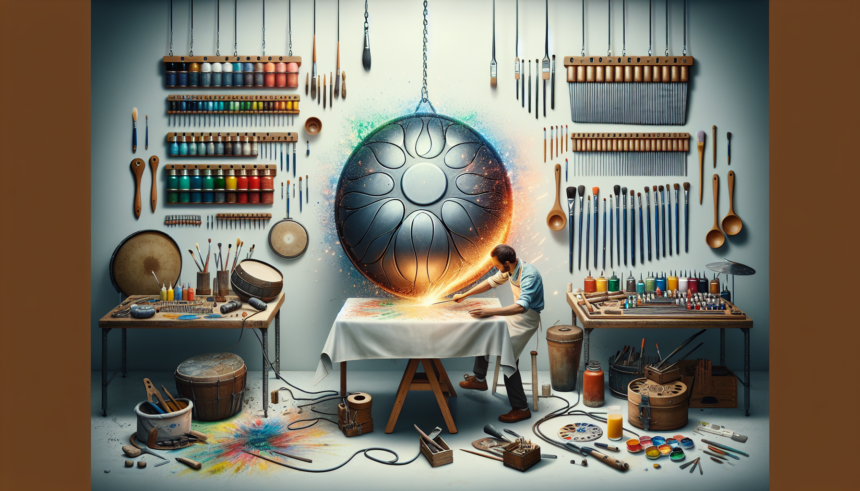<!DOCTYPE html>
<html lang="en">
<head>
<meta charset="UTF-8">
<meta name="viewport" content="width=device-width, initial-scale=1.0">
<title>Handpan Customization Journey</title>
</head>
<body>
<article>
<h1>The Journey of Handpan Customization: From Concept to Creation</h1>
<p>The handpan, with its distinctive resonance and captivating sound, has captured the hearts of musicians and sound enthusiasts worldwide. Beyond its mesmerizing notes, the journey of handpan customization involves a unique blend of artistry, precision, and personal expression. For enthusiasts looking to create a truly one-of-a-kind instrument, the process of customization provides an opportunity for innovation and personal storytelling. Let’s delve deeper into how these incredible instruments are tailored to reflect the individuality of their creators.</p>
<h2>Understanding the Handpan</h2>
<p>The handpan is a relatively recent addition to the world of musical instruments, invented in the early 21st century. It’s a convex steel drum, shaped like a UFO, played with the hands and crafted to produce harmonic sounds. Each handpan is typically designed in specific keys or modes, offering a set of harmonious sounds that encourage creativity and emotional expression.</p>
<h2>The Birth of a Concept</h2>
<p>The journey of customization begins with a concept. For many, this stems from a deep-seated desire to translate personal stories, themes, or moods into the language of music. The initial stage involves brainstorming and conceptualization, often rooted in the player’s unique experiences and musical background. Whether it’s to evoke tranquility, tell a historical tale, or explore spiritual themes, the essence of the concept dictates the customization process.</p>
<p>This phase is crucial as it defines the foundation for the instrument’s design. Musicians will often explore various scales, pitches, and sonic possibilities during this time. Collaborations with skilled handpan makers are common, as they offer invaluable guidance regarding feasible designs, materials, and sonic attributes that align with the client’s vision.</p>
<h2>Design and Technical Specifications</h2>
<p>Once the concept is clear, the focus shifts to design and technical specifications. This stage requires deciding on the scale and key, which are fundamental factors influencing the resulting sound. The scale determines the set of notes that will be available to play, thus impacting the overall musicality of the handpan.</p>
<p>Material choice is another critical factor. The tone field of a handpan can vary greatly depending on the metal used, whether it's stainless steel or nitrided steel. These materials offer different resonances and tonal warmth, each influencing the handpan's acoustic properties differently.</p>
<p>Design elements can also extend to include physical aesthetics. Beyond sound, some may choose to incorporate artwork, engravings, or unique patterns onto their handpan, making it visually as well as audibly distinct.</p>
<h2>The Crafting Process</h2>
<p>The crafting of a handpan is a meticulous practice demanding precision and expertise. The process commences with the choice of a steel sheet, which is then skillfully shaped into the unique domed structure characteristic of a handpan. This shaping is often done through a combination of manual hammering and modern machinery, blending traditional craftsmanship with technological advancements.</p>
<p>Tuning is a pivotal part of the crafting process. Each note is finely tuned by hammering, a painstaking task requiring a masterful ear and hand coordination. This meticulous work ensures that each note not only rings true to pitch but also harmonizes seamlessly with the other notes on the instrument.</p>
<h2>Adding the Personal Touch</h2>
<p>What truly sets a customized handpan apart is the personal touch added during the final stages of creation. Here, artisans may inscribe personalized engravings or patterns that hold significance for the owner. These aesthetic choices might reflect cultural motifs, nature-inspired designs, or abstract art, each tailored to encapsulate the player's identity and aspirations.</p>
<p>This phase often involves close collaboration between the artisan and the musician. Through this interaction, the musician’s vision is translated into the instrument’s final appearance and acoustic texture, ensuring that the handpan reflects their personalized story and musical journey.</p>
<h2>The Final Creation</h2>
<p>After weeks of honing and precision work, the handpan reaches its final form. It is not merely an instrument but a piece of art that holds a distinct character and sound tailored to its owner. The culmination of the customization journey is both rewarding and emotional, as dreams materialize into tangible, melodic expressions.</p>
<p>Upon receiving their personalized handpan, musicians often undergo a trial phase, exploring the full range of notes and scales crafted during the customization process. This exploration allows them to develop a unique playing style and further personalize their musical expressions on the instrument.</p>
<h2>Conclusion</h2>
<p>The journey of handpan customization seamlessly weaves together artistic vision, technical skill, and personal expression to create a unique musical instrument. From conceptualizing the initial idea to seeing it through the meticulous craftsmanship, every step allows for creativity and individuality to shine. Customizing a handpan is more than just selecting notes and patterns; it's about creating an instrument that resonates with the heart and soul of its player.</p>
<p>As the handpan continues to evolve in its designs and popularity, the journey from concept to creation remains a fascinating exploration of sound, touch, and personal aesthetics, ensuring that each customized handpan sings its own distinct melody.</p>
<h2>FAQs</h2>
<h3>1. What materials are commonly used in handpan construction?</h3>
<p>Handpans are typically made from types of steel, such as nitrided steel or stainless steel. These materials provide different acoustic properties, influencing the tone and resonance of the instrument.</p>
<h3>2. How long does it take to customize a handpan?</h3>
<p>Customization times can vary greatly depending on the complexity of the design and the maker's schedule. Typically, a customized handpan may take several weeks to a few months from concept to completion.</p>
<h3>3. Can the tuning of a handpan be changed after it's crafted?</h3>
<p>Once a handpan is tuned, altering its pitch is challenging, as it requires expert craftsmanship to retune without damaging the instrument. It's important to choose the desired scale and tuning before finalizing the customization.</p>
<h3>4. Are there specific scales that are more popular for custom handpans?</h3>
<p>Some popular scales for handpans include the D minor, Celtic, and Hijaz scales, among others. Preferences vary depending on the musician's personal style and musical goals.</p>
<h3>5. Why choose a customized handpan over a standard model?</h3>
<p>A customized handpan is tailored to the individual musician's needs and preferences, offering a unique sound and personalized aesthetic. It allows musicians to infuse their personal stories and artistic vision directly into their instrument.</p>
</article>
</body>
</html>The Journey of Handpan Customization: From Concept to Creation

Leave a comment




